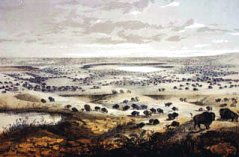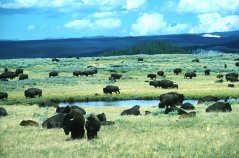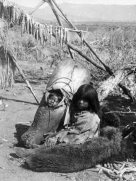Buffalo Tales: The Near-Extermination of the American Bison
Shepard Krech III,
Brown University
©National Humanities Center |
|
(part 4 of 4)
GUIDING STUDENT DISCUSSION / SCHOLARS DEBATE
SHS of North Dakota  |
Stanley, Herd of Bison near Lake Jessie
[North Dakota], 1853-1855
| |
 |
Bison herd
Yellowstone National Park
ca. 1990
| NPS
|
|
|
|
As a central element in the history and imagery of the West, the buffalo, and especially its demise, has
been the focus of arguments for well over one hundred years. To set the stage for discussion, it helps to
try to imagine the landscape at the outset of the nineteenth century—the landscape and flora and fauna
seen by those who explored and traveled the West and recorded their impressions. The best place to
begin is with Lewis and Clark's words; an accessible edition is Frank Bergon's Journals of Lewis and
Clark (1989), which focuses on natural history, and there are numerous excerpts on the Web (see online
resources). A useful (although very different) exercise would be to contemplate through careful
description the changes in that landscape today. Lewis and Clark's trip is coming up for bicentennial
commemoration (2003-2006), which should provide fresh material from a range of popular sources to
engage student interest.
Denver PL  |
Ute children
on a buffalo hide
Utah, ca. 1873
|
|
|
|
 |
The second task is to engage students in discussion about the meaning of buffalo for Plains Indians.
John Ewers's The Blackfeet (1958), Joseph Medicine Crow's From the Heart of Crow Country (1992),
and the more general works by Francis Haines (The Buffalo, 1970/1995), Tom McHugh (The Time of
the Buffalo, 1972) and David Dary (The Buffalo Book, 1974/1989) are all useful sources. What buffalo
meant, of course, will depend on whether the discussion focuses on subsistence, clothing, and other
items of material culture, or on myth, religion, or some other context in which buffaloes in some form
appeared. Students can learn a great deal simply by taking up (in the imagination) the sensory world
created by buffalo products that made existence and lifestyles possible on the Plains for generations, and
by reflecting on the differences not only between what they wear, eat, or use but about the systems of
production that resulted in these products.
The great story about the buffalo is the story of their demise in the nineteenth century. The literature is
voluminous, the arguments acrid and complex. In the last century some argued that Indians played a
role in the near-extinction of the buffalo, others that nonIndians deliberately sought to kill the animals in
order to exterminate the Indians themselves. It might help to sort the arguments into several
categories:
- Indian hunting itself and Indian need for buffaloes to sustain daily life. Both Dan Flores
("Bison Ecology and Bison Diplomacy," Journal of American History, 1991) and I (The
Ecological Indian, 1999) discuss the data.
- Whether Indians were conservationists when it came to buffalo. This is a complex issue and
one that I have written about at length elsewhere (The Ecological Indian). To answer the
question requires a working definition of conservation and an appreciation for American Indian
thought about animals and their environments, that is, an appreciation for ethnoecology—the
ecological thought of a people (ethnic group). I suggest close reading of the Introduction and
the chapter "Buffalo" in The Ecological Indian. It will be important to focus on animals in
general as animate beings, and on comprehending the spaces in indigenous ecosystems. This
would be a valuable way to give students an appreciation for ways of thinking about nature that,
though radically different from western science, are nonetheless rational to the thinkers.
- The demise of the buffalo.
Here the best place to begin is with Dan Flores's seminal essay
"Bison Ecology and Bison Diplomacy," but if this is difficult to obtain, then Drew Isenberg's
The Destruction of the Buffalo (2000) is an excellent recent source. The story is told in the general works by Dary and McHugh referred to earlier. The larger environmental context for the decline of the buffalo was set by climate, drought, disease, fire, horses, cattle, barbed wire, ranchers, railroads, market hunters, and so on. It was driven for the most part by the commodification of the buffalo—tongues, hides, and other parts as highly desired commodities in a greatly expanding marketplace. The demise requires systematic explanation. It resists easy sound bites despite the oft-stated desire of students for straightforward black-and-white answers to complex problems. And it might help to explore whether or not there is an Indian explanation and a nonIndian explanation of the buffalo's demise, or is this too simplistic? At the end of the day, what evidence satisfies your students in this or any other historical explanation?
|
 |
Bison cow and calf
|
Corsi/CAS |
|
 |
To bring the buffalo's story up to date, begin with the Epilogue of The Ecological Indian and proceed
to the web resources that accompany this essay. Several involve the Indian effort to provide safe haven for animals that leave the confines of Yellowstone National Park. Finally, whether the story of the buffalo will be repeated in the new century, with other species, can be explored to extend your discussion into current environmental, economic, and land use issues.
Shepard Krech III is Professor of Anthropology and Director of the Haffenreffer Museum of
Anthropology at Brown University. He was a National Humanities Center Fellow in 1993-94 and 2000-01 and serves on the advisory team for Nature Transformed. His recent publications include The Ecological Indian: Myth and History (1999), Collecting Native
America, 1870-1960, co-edited with Barbara Hail (1999), and "Ecology, Conservation, and the Buffalo Jump," in Stars Above, Earth Below: American Indians and Nature, ed. M. Bol (1998). He is an editor of the forthcoming International Encyclopedia of Environmental History (Routledge, 2003).
Address comments or questions to Professor Krech through TeacherServe "Comments and Questions."
TeacherServe Home Page
National Humanities Center
7 Alexander Drive, P.O. Box 12256
Research Triangle Park, North Carolina 27709
Phone: (919) 549-0661 Fax: (919) 990-8535
Revised: July 2001
nationalhumanitiescenter.org |

Links to Online Resources
Illustration Credits
Works Cited
Comments & Questions






